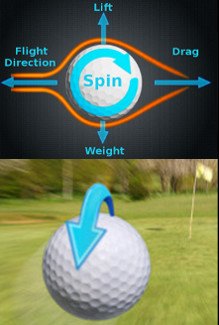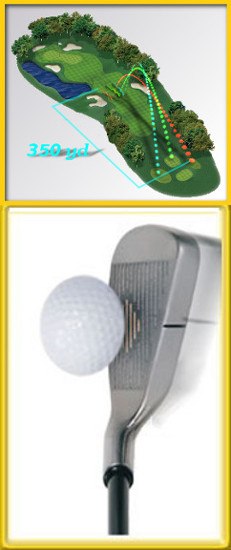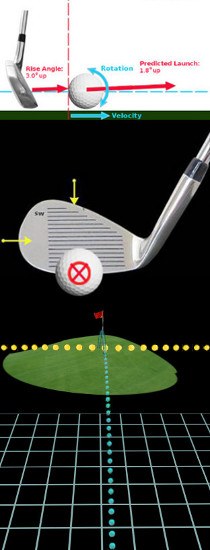
When it comes to golf equipment, the golf ball tends to get lost in the shuffle. This is surprising, as the ball is the most important object in the entire game – without a ball, you simply can’t play golf. So, why do so many amateur golfers overlook the ball when it comes to making their equipment choices? The average player will do ample research before spending money on a new driver or set of irons, but that same player may just grab a box of balls off the shelf in the pro shop before walking to the first tee.
If you are a serious golfer, you need to get serious about your golf ball. It isn’t good enough to just use whatever ball you can find, as that ball may or may not be a good fit for your game. Likewise, you shouldn’t just decide to use a ball that another golfer has decided is the ‘best’ on the market. There is no ‘best’ ball, because each golfer has a unique set of demands for the performance of the ball on the course. The right ball for you will match up perfectly with your strengths and weaknesses. That means it doesn’t matter if the ball is popular or what other players think of it – the only thing that matters is whether or not it will perform when coming off of your clubs.
In this article, we are going to talk about low spin golf balls. Generally speaking, these types of golf balls get a bad rap. They are less expensive than their high spin competition, meaning most players think of them as being lesser models. But is that really the case? In reality, low spin golf balls have strengths and weaknesses, just like any other piece of golf equipment. We are going to look at the pros and cons of low spin balls in this article, and we’ll try to help you decide whether these models are a good fit for your needs.
We do want to point out early in this article that there is virtue in sticking with the same golf ball model for a long period of time, once you have identified one that works for you. Just as is the case with a golf club, you are going to get more comfortable with a golf ball the longer you use it. You’ll get to know the tendencies of the ball, and you’ll be able to anticipate its performance in a variety of situations. It may take a bit of time and experimentation to find a ball that you love, but once you have found it, do what you can to make that relationship last.
All of the content below is based on a right-handed golfer. If you happen to play left-handed, please take a moment to reverse the directions as necessary.

The Benefits of Low Spin Golf Balls
Believe it or not, there are many potential benefits to using low spin golf balls. If you have ever asked for advice in a pro shop regarding which kind of golf balls to purchase, the salesperson will likely point you in the direction of higher spin models. After all, those are the balls that are used by the game’s top players, and they also happen to be the most expensive on the shelves. But are those right for your game? Not necessarily. Let’s take a look at some of the potential gains you could experience by using a low spin ball.
- Added distance. That’s right – you may be able to gain distance by using a low spin ball. When you hit your driver, the amount of backspin you place on the ball is going to have a lot to do with how far the shot travels down the fairway. If you don’t get enough backspin, the ball won’t have the necessary lift to carry a respectable distance. On the other hand, if you have too much spin, the ball will climb high into the air and fall down short of its potential. What you are looking for is a middle ground – enough spin to hold the ball in the air, but not so much that the shot balloons. Depending on the dynamics of your swing, it may be a low spin model that allows you to find this sweet spot. For many average golfers, it is a low spin model which will lead to the greatest possible distances from the tee.
- Straighter flight. This is an important point which is missed by many people, including those trying to sell you the golf balls. When a ball offers a high spin rate, that doesn’t just mean it will offer a lot of backspin – it is going to spin significantly in all directions. So, if you cut across the ball at impact, your rate of sidespin will be greater than it would have been with a low spin model. That means your hooks and slices will be worse than they would be otherwise. In this way, a high spin golf ball can actively damage your performance on the course. Sure, a high spin ball can be a useful weapon when employed by a skilled player, but the average golfer doesn’t have the technique necessary to control such a device. For the typical weekend player who shoots in the 90s and above, a low spin model is desirable if for nothing more than the help it provides in keeping the ball somewhere on the course.
- Improved durability. Some low spin models are going to offer greater durability than high spin balls. This is not always true, but it does tend to be the case across many of the models on the market today. Since high spin balls tend to use a softer cover, that cover can be damaged when the ball strike something like a rock, the cart path, etc. On the other hand, a low spin ball with a hard cover will frequently last several rounds with very little physical damage (assuming you can avoid losing it in that time, of course). So, not only do low spin balls tend to be less expensive than high spin alternatives, you can often use them longer, as well.
As you can see, low spin golf balls might not be so bad after all. Yes, we are going to get into the drawbacks of these kinds of balls in the next section, but for now we have highlighted some potential benefits. They may be able to help you hit your shots farther and straighter, and they may last longer than high spin balls as well. There is a lot there to like, as long as the potential benefits actually bear themselves out during actual play.
Of course, this list of benefits doesn’t highlight one very important point which should be added as well – these kinds of golf balls are almost always the least expensive golf balls in the pro shop. It is usually possible to find a dozen low spin golf balls for around $20 or less, where a dozen high spin, pro-model balls will frequently set you back more than twice that amount. Golf can be an expensive game, so it is great to find savings anywhere you can. With more affordable golf balls in your bag, you just may be able to fit more rounds of golf into your budget.

Low Spin Golf Ball Drawbacks
Inevitably, we had to come to this section. Low spin golf balls aren’t perfect, of course, and they aren’t even considered to be the best option available on the market today. Professional golfers basically ignore this category, picking their ball of choice from the variety of high spin models in production. The drawbacks of low spin balls can’t be ignored, as these points may more than outweigh the positives we covered in the previous section. Without further delay, let’s look at some of the biggest downsides to employing the use of a low spin ball.
- Loss of stopping power. One of the biggest challenges you face as a golfer is bringing the ball to a stop in a timely manner. It is hard enough to just get the ball up to the target, but at that point, the job is only half-done. If you can’t get the ball to stop in the right spot, it will just keep on bouncing and rolling until it finds a nasty spot to settle down. Only when you can successfully stop your ball in the right spots will you be able to make progress on lowering your scores. Since backspin is a main source of stopping power in this game, using a low spin ball is going to make it hard for you to bring your shots to rest before they find trouble. This is especially true when playing on firm, fast conditions. For instance, a seven-iron shot hit into a firm green may stop after just a couple of bounces when you use a high spin ball. In the same situation with a low spin ball, however, that exact shot may keep moving until it eventually rolls off the back of the green. As you are considering golf ball options, take your local playing conditions into consideration. Those in wet climates may be able to get away with a low spin ball, but it’s going to be tough if your local courses tend to be dry and firm.
- Diminished touch in the short game. You need to consider more than just your full shots when picking a golf ball. The way the ball performs in the short game matters tremendously, as you need to be comfortable with the ball when putting and chipping. It should feel good off the club, and you should be able to control it nicely. This can be a problem in many cases when opting for a low spin ball. These types of golf balls tend to feel hard at impact in the short game, making it difficult to feel your distances successfully. You probably won’t be able to use spin to stop your chip shots, and your putts may feel like they are ‘jumping’ off the face. With all of that said, the feel of low spin balls varies from model to model, so you shouldn’t just assume that a given ball will feel lousy. If you are hoping to use a low spin ball in your game, test out a few options to see if any of them perform respectably in the short game category.
- Lower overall flight. Sometimes, there is no replacement for a shot which flies way up into the sky as it heads toward the target. A high trajectory is another way, in addition to spin, that you can help the ball stop relatively quickly. Also, a high flight will help you get over obstacles like trees which may be in your way. You don’t want to hit all of your golf shots as high as possible, but it is a nice skill to have in your bag. With a low spin ball, however, it is going to be awfully difficult to hit a high shot. Simply put, the low spin rate is going to reduce the lift of the shot, and it will almost certainly fly lower on the way to the target.
The downsides of a low spin golf ball are not trivial. These are real problems, and they may be deal-breakers in terms of actually putting a low spin ball to use in your game. At this point, you should think a little bit about the pros and cons of these golf balls. With respect to your game, do you think the pros will outweigh the cons, or will it be the other way around? You may not have a solid answer to this question just yet, but you probably have an idea of which way this is going to go for you.





